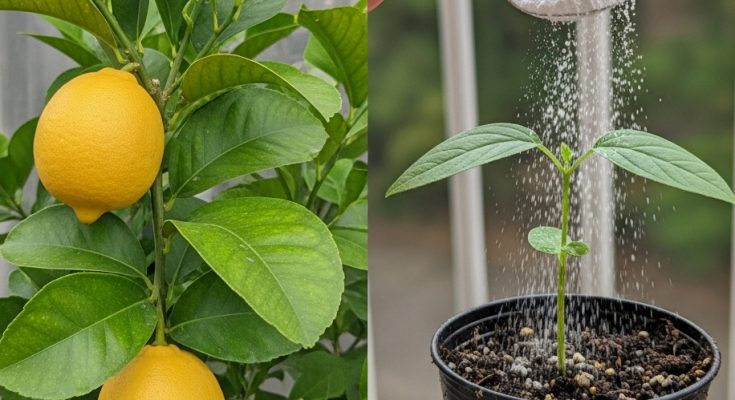If you’re struggling to get your lemon tree to bloom or bear fruit, you’re not alone. Many gardeners face the challenge of lemon trees that seem to stagnate, develop yellow leaves, or fail to produce fruit despite flowering. However, there are several natural and effective methods you can use to encourage healthy growth, prevent flower drop, and ensure fruit development. This article will walk you through a simple, organic process to help your lemon tree thrive and produce an abundance of fruit.
1. Understanding the Need for Proper Fertilization
Fertilizing your lemon tree correctly is key to ensuring healthy growth and fruit production. For this, we will focus on two main ingredients: bone meal and milk.
Bone Meal is rich in essential nutrients like phosphorus, potassium, magnesium, and calcium, which are all critical for plant health. Phosphorus helps promote strong root development and flower production, while calcium plays a vital role in fruit development and resistance to diseases.
Milk is often overlooked in gardening, but it provides many benefits to lemon trees. The calcium in milk strengthens plant cell walls, and the natural sugars can help promote microbial activity in the soil, which assists in decomposing organic matter and providing nutrients to your tree.
2. Preparing the Fertilizer Solution
To begin, you will need the following ingredients:
-
-
500 ml of water (tap water is fine, even if it contains chlorine)
-
3 tablespoons of bone meal
-
3 tablespoons of whole milk (milk will provide additional calcium and other nutrients)
-
Instructions:
-
-
Mix 3 tablespoons of bone meal into 500 ml of water.
-
-
Add 3 tablespoons of whole milk to the solution.
-
Stir the mixture thoroughly to ensure that all the ingredients are well combined.
This mixture will serve as a liquid fertilizer for your lemon tree, supplying it with a rich combination of nutrients to boost its growth and fruiting potential.
3. Applying the Fertilizer
For a young lemon tree, especially one in a container, apply the entire mixture to the base of the tree. For larger trees, use the mixture in moderation, depending on the size of the tree and the pot. Be careful not to over-apply the fertilizer, as too much can harm the plant.
Once you’ve applied the mixture, make sure to cover the top of the soil with dried manure or compost. The dried manure, which has been decomposed over 30 days, will help aerate the soil and further enrich the nutrients available to your tree. Add about six tablespoons of dried manure around the base of the tree.
4. Managing Watering Practices
Proper watering is essential to encourage lemon tree fruiting. One key factor is controlling the amount of water the tree receives during different stages of growth.
-
-
Watering During Flowering: When your lemon tree begins to flower, reduce the watering frequency. Stressing the tree with less water will stimulate it to bloom more vigorously. Water the tree every three days to induce mild water stress. This will encourage the tree to focus on producing fruit.
-
Watering During Fruit Development: Once the first flower buds begin to form into small fruit, return to a regular watering schedule, watering every two days or as needed. Avoid overwatering, as this can cause root rot and hinder fruit production.
-
5. Sunlight Requirements for Fruit Production
Lemon trees need full sun to produce fruit. Ensure your tree gets a minimum of 8 hours of direct sunlight each day. Insufficient sunlight can lead to poor fruit development and weak, yellowing leaves. A sunny spot in your garden or on your balcony is ideal for healthy lemon tree growth.
6. Pest Control with Calcium
Lemon trees are susceptible to a variety of pests, including aphids, mealybugs, and scale insects, which can damage the leaves and flowers. A calcium-rich fertilizer, like the one we’ve prepared using milk and bone meal, helps strengthen the tree’s leaves, making them more resistant to pests. This nutrient boosts the plant’s defenses, so it can better tolerate infestations.
If your tree is showing signs of pest problems, the presence of calcium in the soil and leaves will act as a natural defense, making the plant less attractive to pests. Keep an eye on the tree and remove any pests by hand or with organic insecticides if necessary.
7. Fertilization Frequency
To maintain a steady supply of nutrients and keep your lemon tree healthy, repeat this fertilization process every 30 days. Regular feeding will ensure that the tree’s soil stays aerated, enriched with organic matter, and full of the nutrients necessary for sustained growth and fruit production.
By consistently applying this organic fertilizer and managing your watering and sunlight exposure, your lemon tree will develop a strong foundation for fruitful growth. You will notice an increase in the number of flowers and the development of small fruits, which will eventually mature into full-sized lemons.
Conclusion: Consistent Care for Optimal Fruit Yield
With the right combination of fertilization, watering, sunlight, and pest management, your lemon tree will thrive and bear fruit year-round. By following the steps outlined above, you can address common issues like flower drop, poor fruit production, and weak growth. Regular care, especially using organic fertilizers like bone meal and milk, will provide your tree with the nutrients it needs to flourish. Keep these practices in mind, and soon you’ll have a lemon tree that produces an abundance of fresh, juicy lemons.
